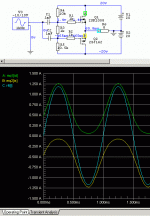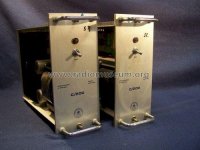It depends on amp's load (your speakers) impedance modulus and your power requirements. 500VA toroid will work fine for 4 Ohms speakers at nominal power and the 300VA for 8 Ohms load (although there are guys here who will tell you that 2kW is a bare minimum).What would be the requirements for the power supply for a stereo amp. Do you really need a 500Va per your schematics ?...
A push pull output stage with 400mA of output bias current will supply almost 800mApk of ClassA to a load.
As long as the output never exceeds that ~800mApk, then the amplifier remains in pure ClassA.
Usually that would be true, but in this case (output LATFETs used without Source resistors) we use the nice square law feature so we get extended class A operation - about three times of usual value (as Mr. Pass measured it) so with Id of 400mA we'll get class A operation equivalent to 1.2A bias with source resistors.
Last edited:
I don't accept this square law hypothesis, whether it comes from Pass or any other Member. It comes down to: is "extended ClassA" = ClassA?
But that does not invalidate my comment.
The amplifier will remain in pure ClassA upto ~800mApk of output current when biased to 400mA.
and his question was:
But that does not invalidate my comment.
The amplifier will remain in pure ClassA upto ~800mApk of output current when biased to 400mA.
and his question was:
If the square law hypothesis is proved to be correct, then there is extra ClassA output available.A user has the bias at 400mA, is this still bias as Class A ?
Last edited:
Your un/acceptance won't change anything, it's proven long time ago - Mr. Pass just offered his measurements and it's easy for anyone to check by looking at waveforms of current through such an output stage...I don't accept this square law hypothesis...
Look here (pages 6 and 7):
http://www.firstwatt.com/pdf/art_sony_vfet_pt1.pdf
Last edited:
The amplifier will remain in pure ClassA upto ~800mApk of output current when biased to 400mA.
Even that isn't entirely true (if one takes a look at the end of the curves)
The last bit of output current is not 'pure'
...The last bit of output current is not 'pure'
It looks like ever since adult virgins became extinct all the puritan purists moved their attention towards pursue of pure class A...
Your un/acceptance won't change anything, it's proven long time ago - Mr. Pass just offered his measurements and it's easy for anyone to check by looking at waveforms of current through such an output stage...
Look here (pages 6 and 7):
http://www.firstwatt.com/pdf/art_sony_vfet_pt1.pdf
Juma, completely agreed of course. But it's worth noting that this benefit is really only valid if the stage is operated in common source mode (ie not as a follower). The local nfb action of a follower attempts to linearise each fet - making the transfer function of the stage rather more of a straight line than a square law. There may be very good benefits of eliminating the source resistors in a follower stage, but significantly enlarged class a is probably not one of them.
...this benefit is really only valid if the stage is operated in common source mode (ie not as a follower)....
Sorry, but my scope (and the sim for that matter) shows the same thing as Mr. Pass' paper does. Also, check the post #41 of this thread.
So, there is a clear class A extended region in the common Drain (Source follower) mode:
Attachments
Last edited:
That's why I saidEven that isn't entirely true (if one takes a look at the end of the curves)
The last bit of output current is not 'pure'
crossover distortion is avoided when the amplifier is still in pure ClassA.A push pull output stage with 400mA of output bias current will supply almost 800mApk of ClassA to a load.
The curvy bits of the transfer curve is what is crossover distortion.
That is where the ClassAAA etc fell down. The crossover distortion is still there. Zero current in the unused device is NOT the definition of ClassA. ClassA is no crossover distortion.
This is where the cheats using a not quite turned off device that does not contribute to elimination of crossover distortion fall down.
It is this curvy bit at the bottom of the transfer characteristic of the square law that has not yet convinced me that using that part of the transfer characteristic is really ClassA.
I have read some of the technical discussions by the proponents of the "new extended ClassA".
I don't have the knowledge to peer review the technical argument.
I have yet to see reviews from "technically competent" reviewers of the truth in the square law claims.
I remain unconvinced at this stage.
The question was:
The answer is still yes !A user has the bias at 400mA, is this still bias as Class A ?
Sorry, but my scope (and the sim for that matter) shows the same thing as Mr. Pass' paper does. Also, check the post #41 of this thread.
So, there is a clear class A extended region in the common Drain (Source follower) mode:
Thanks juma and I'll take a look - what is the bias current set to in this sim ?
ClassA is no crossover distortion.
By that definition, Glen Kleinschmidt's 1024W version of the Technics SE-A1 is every bit a Class A power amp design.
See the green and the yellow traces - somewhat below 500mAThanks juma and I'll take a look - what is the bias current set to in this sim ?
It depends on amp's load (your speakers) impedance modulus and your power requirements. 500VA toroid will work fine for 4 Ohms speakers at nominal power and the 300VA for 8 Ohms load (although there are guys here who will tell you that 2kW is a bare minimum).
Usually that would be true, but in this case (output LATFETs used without Source resistors) we use the nice square law feature so we get extended class A operation - about three times of usual value (as Mr. Pass measured it) so with Id of 400mA we'll get class A operation equivalent to 1.2A bias with source resistors.
Thanks a lot for the answer
Member
Joined 2009
Paid Member
oh boy, arguing over definitions for Class A in the 'grey zone' where currents are low in some of the power devices always seems to crop up from time to time. I remember the KRILL thread. Nobody here is trying to 'sell' the amplifier for something it isn't, but rather for what it is - an amplifier that they have built, tested and listened to and have found it to be very good.
Question - would this amplifier sound as good with vertical FETS (and a suitable temp-co bias) with the same square-law assisted behaviour ?
Question - would this amplifier sound as good with vertical FETS (and a suitable temp-co bias) with the same square-law assisted behaviour ?
...Question - would this amplifier sound as good with vertical FETS (and a suitable temp-co bias) with the same square-law assisted behaviour ?
I'm afraid that direct comparison is not possible because usual vertical suspects (IRFP9240/240) will go wild without Source resistors and using them eliminates square law advantage.
As far as my tests went, this amp sounds better with Laterals than with IRFP verticals (source resistors and Vgs multiplier thermal compensation added).
As a matter of fact, I never found a topology (few dozens tested) where IRFPs sounded very good - very high bias (1.5 - 2 A) helps but there are always some "grainy" sounding artifacts left in mids and highs. Toshiba parts (2sk1530/2sj201 and especially 2sk2013/2sj313) sound much better but they still need source resistors...
Last edited:
oh boy, arguing over definitions for Class A in the 'grey zone' where currents are low in some of the power devices always seems to crop up from time to time. I remember the KRILL thread. Nobody here is trying to 'sell' the amplifier for something it isn't, but rather for what it is - an amplifier that they have built, tested and listened to and have found it to be very good.
Question - would this amplifier sound as good with vertical FETS (and a suitable temp-co bias) with the same square-law assisted behaviour ?
Sorry guys, I didn't want to open up a can of worm.
I was simply asking because I found 2 amplifier (Cinemeccanica C/200) in my so overwhelming garage and I'd like to use the power transformer (roughly +/- 40Vac, 300VA)
BR,
Eric
Attachments
- Home
- Amplifiers
- Pass Labs
- 25W Class A amp with Lateral MOSFETs

